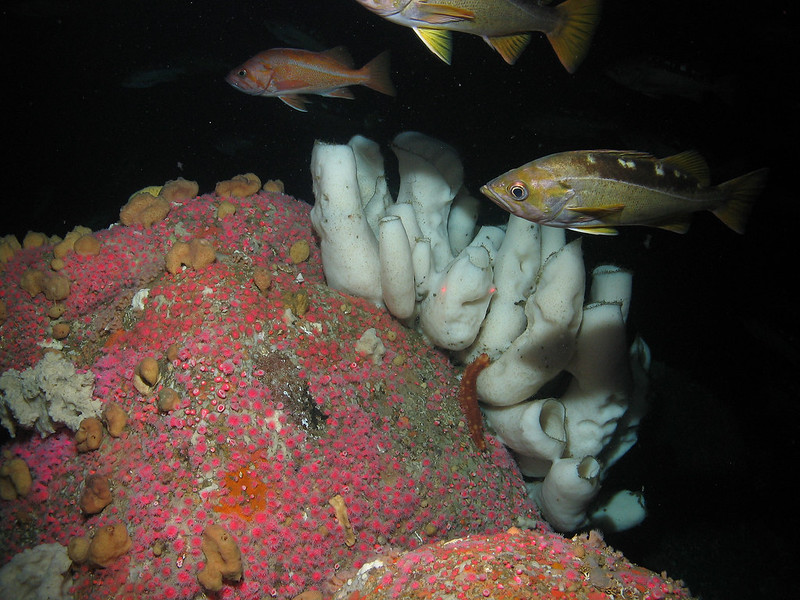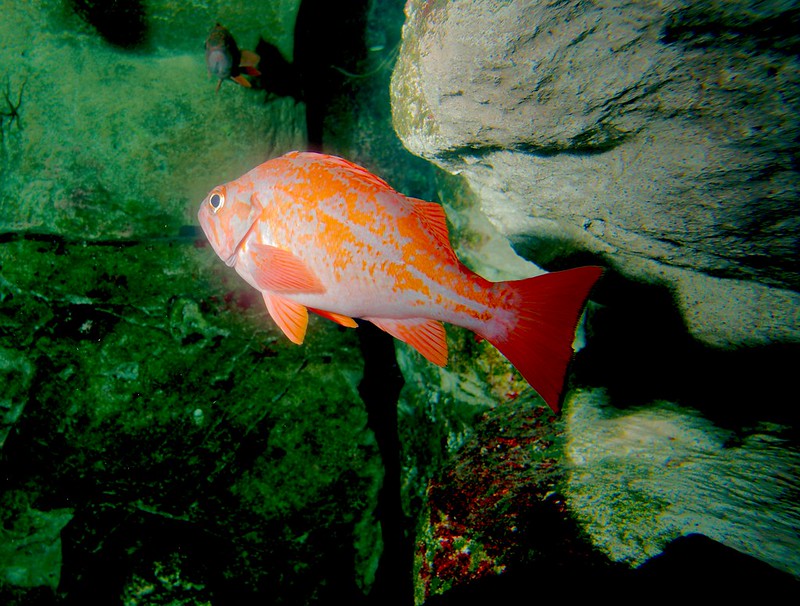
Six exempted fishing permits move forward
The Council has forwarded six 2021-2022 exempted fishing permits (EFP) applications to NMFS. They focus on year-round coastwide midwater rockfish; California Department of Fish and Wildlife recreational cowcod sampling in California; yellowtail rockfish Jig fishing off California; commercial midwater hook-and-line rockfish in the Rockfish Conservation Area off Oregon; Washington Department of Fish and Wildlife enhanced yelloweye recreational fishery biological sampling; and the Monterey regional EFP targeting chilipepper rockfish.
An EFP authorizes a vessel to engage in an activity that is otherwise prohibited in order to collect experimental data. The objectives of EFPs vary, and may include promoting increased utilization of underutilized species, increasing harvest efficiency, exploring ways to reduce effort on depressed stocks, encouraging innovation and efficiency in the fisheries, providing access to stocks while measuring the bycatch, or evaluating proposed management measures.
Two EFPs are noteworthy because they are new this cycle. The CDFW EFP will investigate cowcod catch in the recreational fishery, reflecting the rebuilt status of cowcod. The EFP will improve scientists’ and managers’ understanding of the species. Additionally, the WDFW EFP will investigate yelloweye rockfish catch in the recreational fishery. This EFP will provide more knowledge about how the recreational fishery impacts the species, and is key to improved understanding of how the species is rebuilding.
Final harvest specifications and management measures adopted for 2021, 2022
In June the Council adopted final 2021 and 2022 harvest specifications for stocks and stock complexes by confirming their April 2020 decision for all stocks except shortbelly rockfish, which will be designated an Ecosystem Component species.
Concerns over incidental shortbelly bycatch prompted the Council to recommend that if the fishery exceeds 2,000 mt of shortbelly rockfish in a calendar year, the Council will investigate the reasons why the overage occured. The Council could then consider changing management measures for shortbelly based on the results. The Groundfish Management Team (GMT) will continue to monitor the stock, and inseason catches will be tracked using the species scorecard.
The Council adopted its preliminary preferred alternative as the preferred alternative for routine management measures, which include annual catch limit deductions for tribal, research, recreational, exempted fishing permit, and incidental open access fisheries, as well as set-asides for the at-sea whiting fisheries. These measures are summarized here and detailed here.
The Council also adopted trip limits for incidentally-caught yellowtail rockfish in salmon troll fisheries both north and south of 40° 10’ N. lat. For the salmon troll fishery north of 40° 10’ N. lat., the Council eliminated the salmon-to-yellowtail ratio requirement and recommended a monthly trip limit of 500 lbs of yellowtail rockfish, with the additional requirement that salmon must be included in the landing. For the salmon troll fishery south of 40° 10’ N. lat, the Council adopted 1 lb. of yellowtail rockfish per 2 lb. of Chinook salmon landed, with a cumulative monthly limit of 200 lbs. of yellowtail rockfish.
The Council adopted the GMT’s recommended harvest guidelines and allocations and established a 50 mt annual catch target for cowcod south of 40° 10’ N. lat. Further, they confirmed the two-year trawl/non-trawl and commercial trip limit for all stocks that were in the preliminary preferred alternative.
Flatfish gear restrictions within the non-trawl Rockfish Conservation Area (RCA) south of 42° N. lat were removed. The Council established a 50 lbs-per-month shortspine thornyhead and 50 lbs.-per-month longspine thornyhead trip limit north of 34° 27’ N. lat. The Council also converted widow rockfish, petrale sole, lingcod south of 40° 10’ N. lat, and Slope Rockfish complex (including blackgill rockfish) allocations from Amendment 21 formulas to new two-year allocations.
The Council adopted the recreational management measures recommended by the California Department of Fish and Wildlife, the Oregon Department of Fish and Wildlife, and the Washington Department of Fish and Wildlife, as well as the treaty tribal management measures recommended by the tribes.
Additionally, the Council adopted multiple depth adjustments to the non-trawl RCA off California, Oregon, and Washington.
In California, recreational management area depth changes to the RCA were adjusted as follows:
- Mendocino Groundfish Management Area (Cape Mendocino to Point Arena): Increase the allowable depth during the open season (May through October) from 20 to 30 fathoms.
- San Francisco Groundfish Management Area (Point Arena to Pigeon Point): Increase the allowable depth during the open season (April through December) from 40 to 50 fathoms.
- Southern Groundfish Management Area (Point Conception to the U.S.-Mexico border): Increase the allowable depth during the open season (March through December) from 75 to 100 fathoms.
Also in California, commercial non-trawl RCA depth boundaries were adjusted as follows:
- A new management line was created at 38° 57.5′ N. lat. (Point Arena) in order to define RCA boundaries.
- Between 38° 57.5′ and 34° 27′ N. lat. (Point Arena to Point Conception), the depth of the shoreward RCA boundary was increased from 40 to 50 fathoms. (The shoreward RCA depth between 40° 10′ N. lat. and 38° 57.5′N. lat. will remain unchanged at 40 fathoms.)
- From 34° 27′ N. lat. (Point Conception) to the U.S.-Mexico border, the depth of the shoreward RCA boundary was increased from 75 fathoms to 100 fathoms.
The Council also recommended moving the shoreward boundary of the non-trawl RCA from 30 fm to 40 fm between 40° 10’ N. lat. and the Oregon/Washington border (46° 16’ N. lat) and to allow only hook and line gear, except for dinglebar and longline, to be used. Dinglebar and longline gear types (as defined at 50 CFR 660.11) cannot be fished in this area and depth range..
Finally, the Council recommended reopening the South Coast and Westport Yelloweye Rockfish Conservation Areas off Washington.
NMFS will next submit a preliminary rule for public review, and is set to finalize the regulations with a target implementation date of January 1, 2021.

Groundfish stock assessment finalized for 2021
In June the Council adopted groundfish stock assessments to be conducted in 2021 as follows: full assessments for vermilion and sunset rockfishes (to be assessed as a complex of the two species), Dover sole, and lingcod; data-moderate assessments for spiny dogfish, copper rockfish, quillback rockfish, and squarespot rockfish; an update assessment of sablefish; and catch-only projection updates for arrowtooth flounder, canary rockfish, darkblotched rockfish, and petrale sole.
Three Stock Assessment Review (STAR) panels will be held next year to review the full assessments, with one panel devoted to vermilion and sunset rockfishes and one panel devoted to lingcod. A third STAR panel will review the full assessment for Dover sole and the data-moderate assessment for spiny dogfish, which is expected to be complex and in need of a more robust review process.
The Council also adopted a list of candidate stocks for assessment in 2023 as follows: petrale sole, black rockfish, sablefish, rougheye rockfish, shortbelly rockfish, and redbanded rockfish are candidates for full assessments; yellowtail rockfish north of 40° 10’ N lat. is a candidate for a full or updated assessment; yellowtail rockfish south of 40° 10’ N lat., greenspotted rockfish, and flathead sole may be subject to full or data-moderate assessments; bank rockfish, brown rockfish, starry rockfish, longspine thornyhead, shortspine thornyhead, English sole, rex sole, treefish, olive rockfish, and speckled rockfish are candidates for data-moderate assessments; yelloweye rockfish is a candidate for an updated assessment. (Italicized stocks are higher priority). Advance notice of stock assessment priorities is considered helpful in prioritizing data collection efforts. A final decision on 2023 stock assessment priorities is scheduled for June 2022.
Council adopts final changes to electronic monitoring regulations
Final changes to West Coast electronic monitoring program regulations were adopted by the Council in June, including a recommendation that implementation of the program be delayed until January 1, 2022.
The Council recommended that National Marine Fisheries Service (NMFS) extend the existing electronic monitoring exempted fishing permits (EFPs) until the amended regulations take effect, and allow new EFP entrants to continue developing catch handling rules in the bottom trawl fishery.
The regulatory changes will include increasing the hard drive submission deadline to 72 hours from the beginning of the offload, and requiring that data be removed before reusing hard drives only if end-to-end encryption is not used; removing the limit on switching between observers and electronic monitoring for whiting vessels; removing the requirement for a mothership/catcher vessel endorsement to use electronic monitoring on mothership catcher vessel trips; allowing providers to receive and enter logbook information, rather than submitting it to NMFS; requiring deadlines for service provider reports, logbook data, vessel operator feedback, summary and data compliance reports; aligning data retention requirements with NMFS directives; and making minor corrections to regulations and definitions.
The NMFS and the Council will continue to develop the electronic monitoring program guidelines and provider manual to ensure it is consistent with the revised proposed rule and other directives. Public webinars will be held during the summer and fall of 2021 to discuss their development. Please visit the Council’s electronic monitoring page for more information.
Inseason adjustments
The Council increased bocaccio south of 40° 10’ N. lat. trip limits for limited entry fixed gear (LEFG) and open access. The recommended inseason adjustments would set the bocaccio trip limits for LEFG from 40° 10’ North latitude (N. lat.) to 34° 27’ N. lat at 6,000 lbs per two months; LEFG south of 34° 27’ N. lat. at 6,000 lbs per two months; and the open access trip limits for bocaccio south of 40° 10’ N. lat. at 4,000 lbs per two months.
Sablefish Management and Trawl Allocation Attainment Committee provides final report to the Council
The Sablefish Management and Trawl Allocation Attainment Committee (SaMTAAC) submitted its final report in June. The committee was created to address under-attainment of non-sablefish trawl allocations and unharvested sablefish quota pounds south of 36° N. latitude.
The SaMTAAC’s final report to the Council includes a “no action” alternative and three alternatives that would limit the harvest of northern sablefish by vessels using non-trawl gear in the trawl catch share fishery. When the Council takes its next action on this issue in September, it will decide whether or not to move the deliberations forward, and, if so, adopt a purpose and need and consider further development of alternatives.